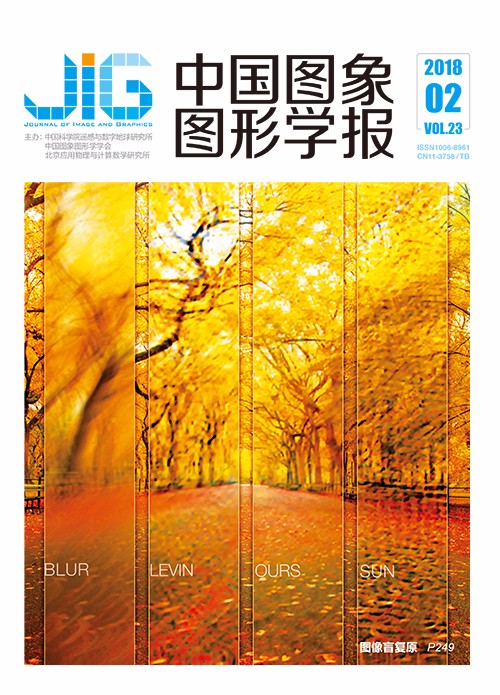
可学习高阶微分方程的图像盲复原
程世超1,2, 刘日升3,2, 樊鑫3,2(1.大连理工大学数学科学学院, 大连 116024;2.辽宁省泛在网络与服务软件重点实验室, 大连 116621;3.大连理工大学-立命馆大学国际信息与软件学院, 大连 116621) 摘 要
目的 图像盲复原是图像处理中的常见的重要问题之一,具有巨大的研究价值和广泛的应用。通常情况下,相机抖动,聚焦不准,环境噪声等因素都会造成图像模糊。由于图像盲复原需要同时求解模糊核和清晰图像,导致该问题是病态的而难于求解。现有的盲复原方法可以分为两大类,一类是基于最大后验概率来同时估计潜在图像和模糊核的方法,但是这样耦合在一起的方法由于先验条件和初值设置不恰当,常常会导致最终求得的是问题的平凡解,以至于盲复原的效果并不理想。另一类是基于变分贝叶斯来估计模糊核,这种方法通常是采用最大化强边图像的边缘概率,由此估计的模糊核鲁棒性较强,但是对潜在图像的强边条件要求比较高,计算复杂度和实现难度都较大。鉴于以上方法的优缺点,提出基于高阶微分方程学习的方法来实现图像去模糊。方法 借鉴传统的迭代演化方法和网络学习方法各自的优势,将网络学习到的特征(引导图像,卷积滤波器,稀疏测度)融入到高阶微分方程的演化过程中区,提出可学习的基于高阶微分方程的演化来模拟图像的演化过程。具体地,先用范数约束得到一个粗略的强边引导图像,然后将学习到的卷积滤波器和稀疏函数一起作用在当前的潜在图像上,得到一个关于图像的更好的梯度下降方向,将此作为微分方程演化的一个步骤,得到一个更为精炼的强边图像。最后用精炼的强边图像来估计模糊核。该方法可以通过先验知识和训练数据来有效地控制模糊核的估计,进而得到较为清晰的盲复原结果。结果 在图像建模层面上,用非盲复原的方法验证了本文提出的微分方程演化过程是可行的。通过和其他盲复原方法做对比,在不同的基准图像数据库上的定量的实验中,本文方法在数据库上的峰值信噪比,结构相似度分别达到30.30,0.91,误差率低至1.24;比其他方法的结果都要好,在时间上,虽然我们的算法不是用时最少的,但是和性能相当的本文的方法相比,本文算法时间消耗远比该算法少。在各种不同类型的模糊图像去模糊结果也表明了本文方法是有效的。结论 本文可学习的高阶微分方程去模糊的方法,能够有效地估计模糊核,进而更好地恢复出清晰图像。实验结果表明本文方法在各种场景中具有较高的灵活性,都能自适应地对图像去模糊。
关键词
Blind image deblurring via learnable higher-older differential equation
Cheng Shichao1,2, Liu Risheng3,2, Fan Xin3,2(1.School of Mathematical Sciences, Dalian University of Technology, Dalian 116024, China;2.Key Laboratory for Ubiquitous Network and Service Software of Liaoning Province, Dalian 116621, China;3.DUT-RU International School of Information Science & Engineering, Dalian University of Technology, Dalian 116621, China) Abstract
Objective Blind image deblurring is one of the main phases in most media analysis tasks, which has better research value and broad application. Such as image feature extraction, classification and retrieval. In fact, the shake of camera, out of focus or noise in circumstances, both of them can result in blurred image. It has been a long history to design algorithms to address blind deconvolution task. So far, there exists two general categories for image deblurring:One is by simultaneously estimate the latent image and the blur kernel under a commonly used framework maximum a posteriori (MAP), which has been appeared on many existing works. Many efforts have been made to improve the performance of MAP. Both estimate kernel on gradient domain and regularizer on latent iamge are designed to enhance the effective of deblurring. The most widely used form is norms. However, it has been demonstrated that such joint estimation strategies may lead to the undesired trivial solution since of the priors or initial value is not reasonable, and always bring blurred result. The other is Variational Bayesian (VB), which often marginalizes the edge probability of the blind kernel from all possible sharp latent images. The solution is always stable, but the higher requirement of strong edges for latent images is difficult. It becomes hard to achieve since of the complexity and computation. Based on the advantages and disadvantages of them, we proposed a new algorithm for blind image deconvolution based on learnable higher-order differential equation. Method In this paper, we absorb the advantages of traditional differential equation iterations method and learnable networks method, then joint the features (including strong edge image, convolutional filter and sparsity measure) learned from networks into the processing of the iterations of differential equation. Finally, we propose a learnable higher-order differential equation processing to formulate the image propagation. Specially, we first learn a rough sharp guidance, then use the convolutional filter and sparsity measure together on the current latent image. By combining them, we can obtain a better gradient direction as one step in the propagation of the higher-order differential equation. The blur kernel estimation can be efficiently controlled by both cues and training data, it also can bring a better blind deconvolution result. Result We first verify our higher-order differential equation propagation on non-blind image deconvolution, the comparisons with other methods show that our propagation is feasible. For blind deconvolution, the quantitative results with some state-of-the-art methods on two benchmarks indicate that our method has better performance on the indexes:PSNR, SSIM and ER. Specifically, the average PSNR, SSIM and ER on Levin et al.'s dataset are 30.30, 0.91 and 1.24, which are the best compared with other methods. For time consumption, our proposed system isn't the fastest, but is already far faster than the method, which has the second performance on the three quantitative metrics. We also test our method on special images, such as facial image, text image and nature blurry image. No matter whole image or detail restorations, our method has better performance than others on visualization. Conclusion Our method based on the propagation of the higher-order differential equation can estimate blur kernel effectively, which is better for restoring clear image. It's flexible and adaptive to deblur in all kinds of blurred scene.
Keywords
|



 中国图象图形学报 │ 京ICP备05080539号-4 │ 本系统由
中国图象图形学报 │ 京ICP备05080539号-4 │ 本系统由